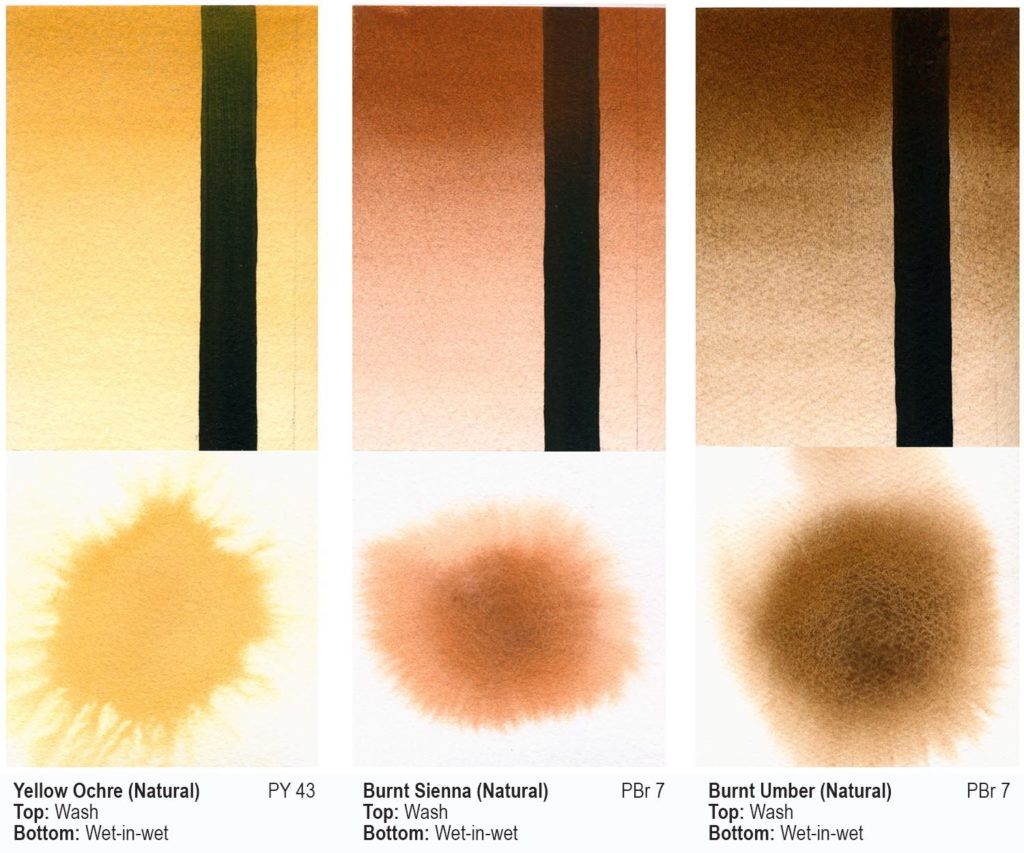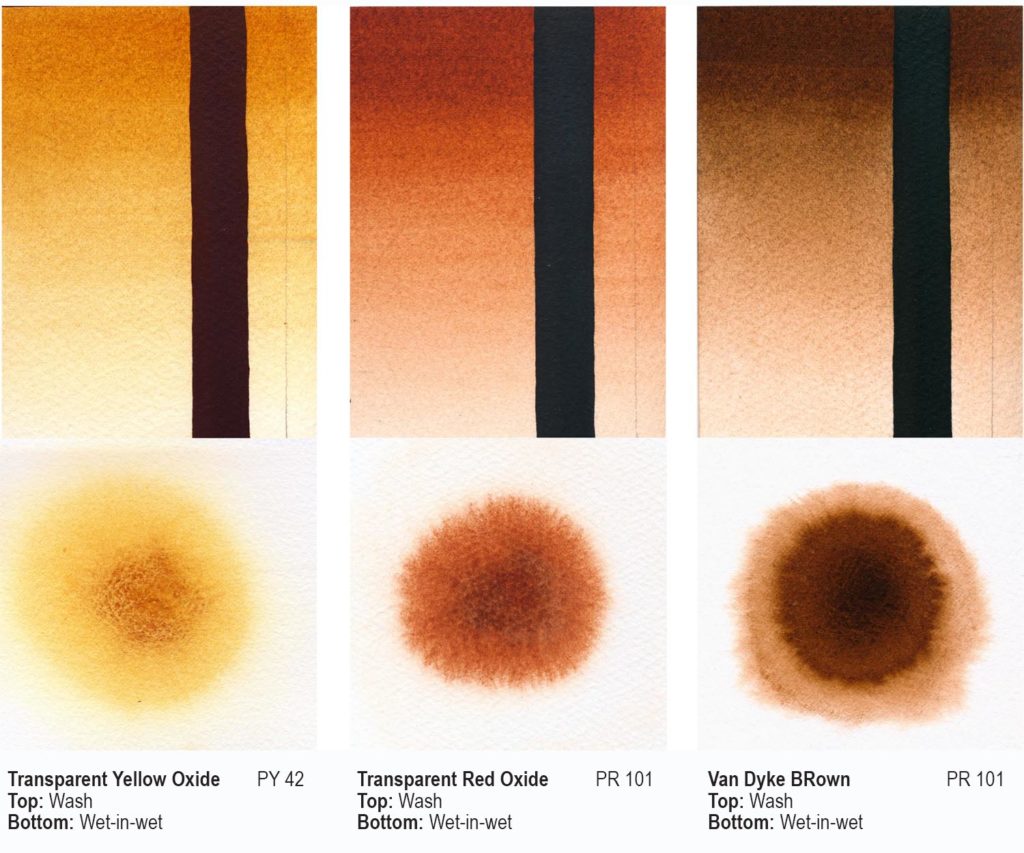The description “earth pigment” originally indicated both a natural material mined from the earth, and ancient iron oxide colors dominated by browns, tans, golden yellows, and rusty oranges. These are the painters’ traditional Sienna, Ochre, and Umber color families. Natural pigments now have synthetic siblings that greatly expand the earth color family. Synthetic iron oxides are the result of chemical processes and being human-made, they offer many color options. This article will look at six QoR Watercolors, three with natural pigments and three with synthetic pigments.
We use the word “Natural” in the name of QoR watercolors made with iron oxide pigments created from the earth herself, pigments such as Pigment Yellow 43 (PY43) and Pigment Brown 7 (PBr7). Of the three ‘earth’ iron oxides this article explores, PY43 gives color to QoR Yellow Ochre (Natural), and PBr7 to Burnt Sienna (Natural) and Burnt Umber (Natural). Paints with these names historically incorporate true earth pigments, and QoR is honoring this tradition.
We will also investigate three of our synthetic iron oxide watercolors, QoR Transparent Yellow Oxide, Transparent Red Iron Oxide, and Van Dyke Brown. Synthetic pigments used in earth colors are often versions of Pigment Yellow 42 (PY42) or Pigment Red 101 (PR101). In this case, Transparent Yellow Oxide uses PY42 and both Transparent Red Oxide and Van Dyke Brown contain PR101. As highlighted in two of the paint names, these particular synthetic oxide paints lean towards transparency even in saturated washes.[i]
Some watercolorists like the results and behavior of natural pigments, others prefer the synthetics, and some embrace both. The images below will provide a starting point for exploring the opportunities offered by our QoR iron oxide watercolor paints. These examples are painted on Fabriano Artistico 140 lb. Cold Pressed paper. For the graded washes, we show opacity by applying the watercolor over a stripe of GOLDEN Black Gesso and an HB graphite line. For the wet-in-wet examples, a brush was used to apply diluted paint to the center of a wet piece of watercolor paper and the test allowed to dry flat.
Pigments have personalities, and the way the paint is milled and treated in formulations impacts how they behave in different contexts. How an artist uses them can also influence paint behavior. Diluted more or less, applied to a tilted or flat surface, on textured or smooth paper, damp or wet or dry paper, intermixed with granulating or non-granulating paints: these are all conditions that may impact how the paint behaves on the paper. This is demonstrated in our examples through the differences in granulation in the wet-in-wet examples versus the washes. In the case of the graded washes, dragging the brush against the sharp edge of the paper at the start of the stroke removed some of the granulating pigment, resulting in a finer visual texture.
Yellow Ochre (Natural) PY43
QoR Yellow Ochre (Natural) provides a semi-opaque soft neutralized yellow with a slight bias in the direction of peach in light washes. The partial opacity creates a soft comforting quality to the color that continues even in the palest tints. This paint does not tend to granulate.
Transparent Yellow Oxide PY42
Golden brown, transparent, and granulating, QoR Transparent Yellow Oxide offers a clear neutralized yellow (tan) in thin washes and a warm glowing yellowish brown when applied with less dilution. Depending upon application, the granulation may range from moderate to very fine.
Burnt Sienna (Natural) PBr7
QoR Burnt Sienna (Natural) is a semi-opaque red-brown with a moderate saturation that imparts a soft quality to the color. Granulation is impacted by the handling. The pigment particles that sink with granulation may appear more brown and the finer surrounding particles more rusty, which creates a beautiful two-toned result. In light washes, Burnt Sienna creates a lovely muted rose-brown.
Transparent Red Oxide PR101
QoR Transparent Red Oxide offers an intense transparent rust-red in less dilute applications, and a neutralized orange-red in paler washes. Granulation varies from fine to heavy depending upon application, and the pigment that sinks in a wash often shows as more brown against the bright rust red of the finer particles.
Burnt Umber (Natural) PBr7
QoR Burnt Umber (Natural) is a slightly opaque granulating watercolor offering a gorgeous dark brown in less dilute applications, and a slightly warmer tint in more diluted washes. Granulation amount may vary, and the heavier particles that sink tend to be a darker brown than the fine reddish brown particles surrounding them. This can create a lovely two-toned look.
Van Dyke Brown PR101
QoR Van Dyke Brown offers a strong transparent reddish brown, intense in mass tone yet shifting to a neutralized orange tint when greatly diluted with water. Granulation can be evident or subtle depending upon application, with the pigment separating into a warm dark brown, clear red-brown, and pale brownish rust. These divisions may be very finely scattered, as in the wash, or more clearly seen as in the wet-in-wet example.
[i] For more information on natural and synthetic iron oxides, see Michael J. Potter, “Iron Oxide Pigments” (1998). Accessed 11/18/2017 (https://minerals.usgs.gov/minerals/pubs/commodity/iron_oxide/750400.pdf)
About Cathy Jennings
View all posts by Cathy Jennings -->Subscribe
Subscribe to the newsletter today!



This is excellent and very helpful, but I do wish you’d do a new post showing how Transparent Brown Oxide compares to the Red Oxide and Van Dyke Brown! In various swatches I’ve seen online they look very different, sometimes the red appearing deeper, and sometimes the brown.
Hello Jenn,
Thank you for the suggestion! I will forward this request to those who determine content for social media, as it might be a fun topic for comparison not just between these three paints in QoR, but between the paints in all three brands (QoR, Williamsburg, and Golden).
Warm Regards,
Cathy